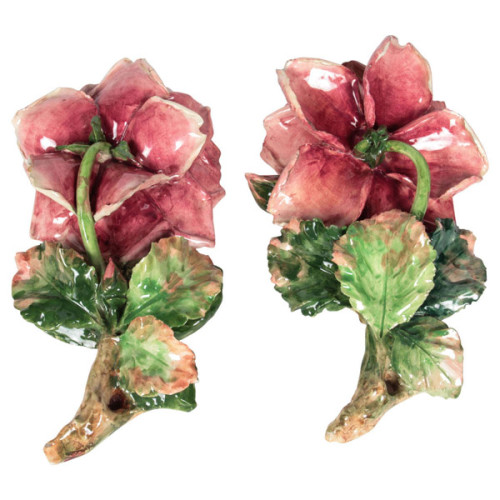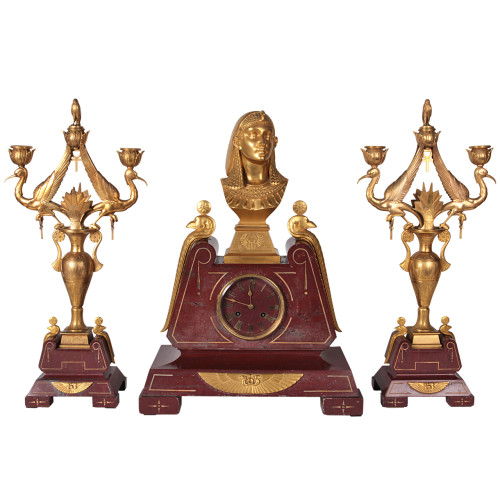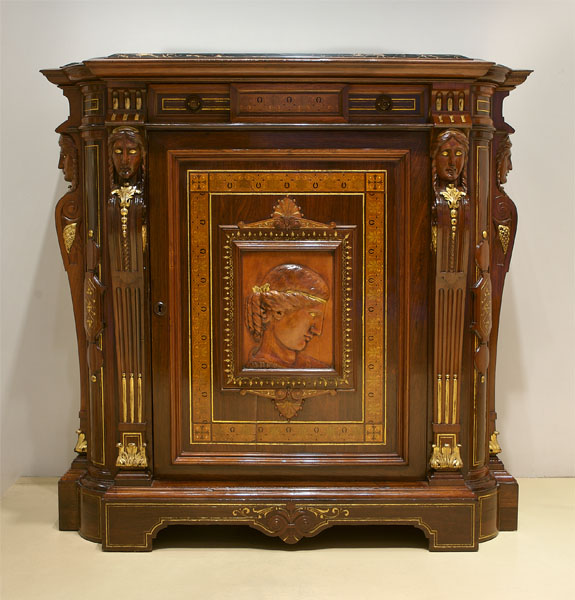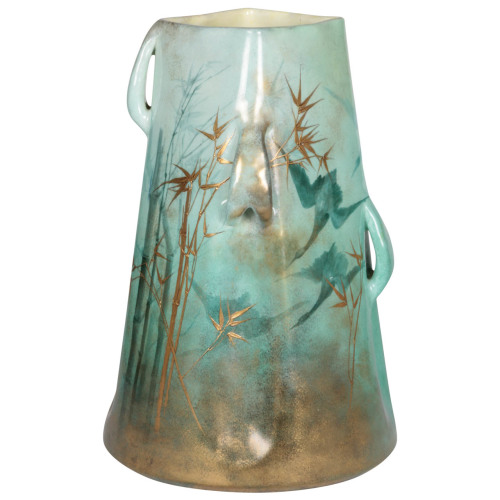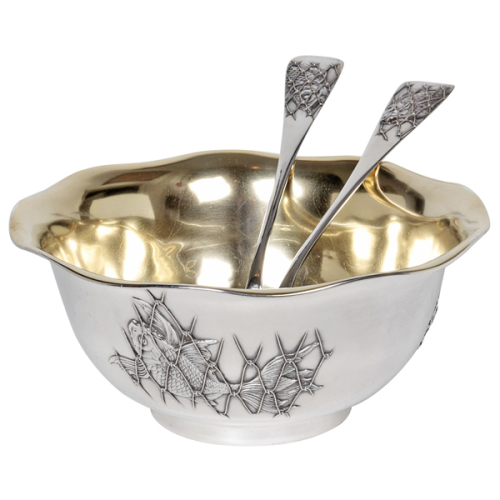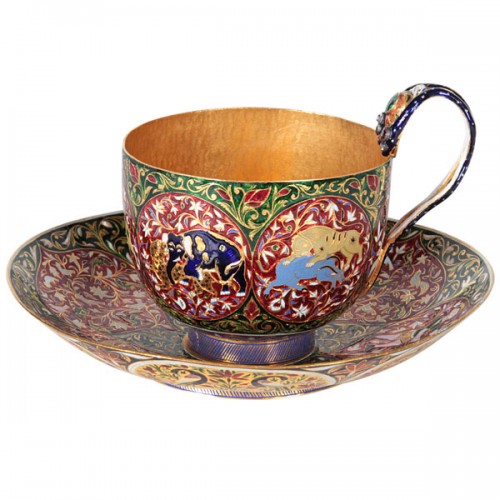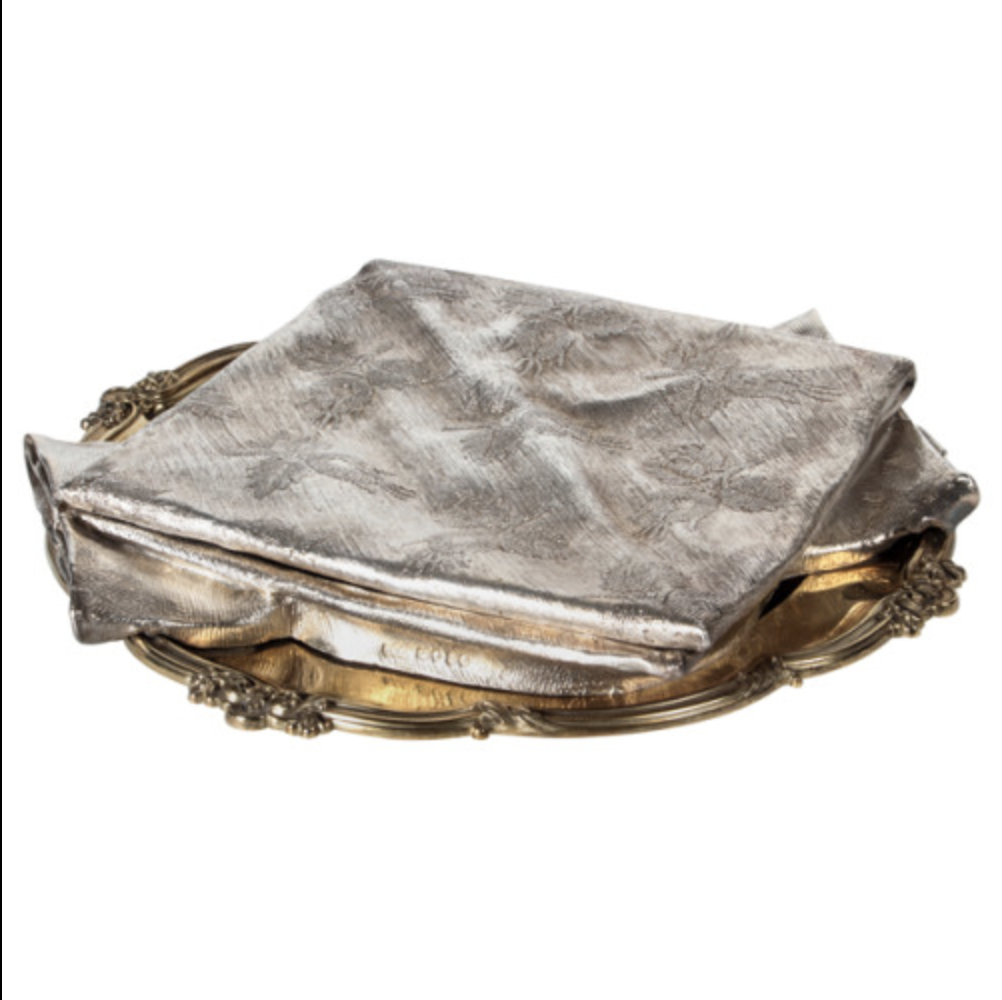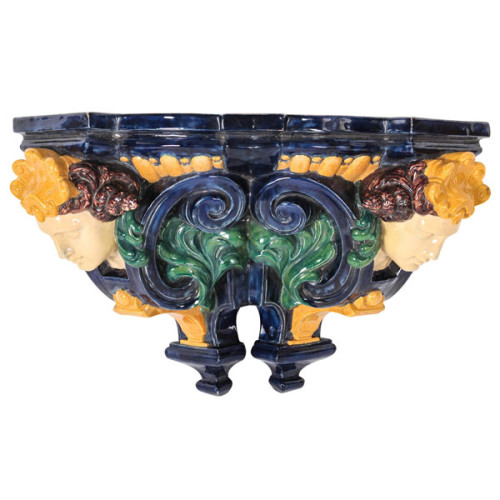19th Century

19th Century
-
Italian Majolica Pair of “Rose” wall pockets c. 1885
ITALIAN MAJOLICA
Pair of “Rose” wall pockets c. 1885
Three dimensional realistically rendered pink roses with leaf and stems all in the Barbotine technique
Marks: Made in Italy
Barbotine is the French term for ceramic slip or a mixture of clay and water for molding or decorating pottery. This technique was used to create applied adornments on 19th century majolica items.
H: 13″ x W: 7 1/4″ x D: 4 1/4″
-
Paul-Auguste Gagné, French Egyptian Revival Gilt Bronze Garniture Set c. 1875
Paul-Auguste Gagné (Sculptor) France
Egyptian Revival garniture set, circa 1875
Gilt bronze and carved rouge marble mantle clock and candelabra in a high Egyptian Revival style
Marks: P.A. Gagne (elaborate incised scroll signature on the back of the portrait bust)
For more information on Gagné see: Dictionnaire des peintres, sculpteurs, dessinateurs et graveurs, vol. 4, E. Bénézit (Paris: Librairie Gründ, 1976) p. 579.
For other related Egyptian Revival garniture sets see: Egyptomania: Egypt in Western Art, 1730-1930 (Paris: Éditions de la Réunion des Musées Nationaux and Ottawa: National Gallery of Canada, 1994)
H: 20 3/4″ x D: 6 3/4″ x W: 14 1/2″
-
Gustave Herter Renaissance revival “portrait” cabinet 1858 – 1864
GUSTAVE HERTER (1839-1883) b. Germany/New York
Renaissance revival “portrait” cabinet 1858 – 1864
Carved cherry wood portrait plaque, mahogany, exotic wood inlays and gilding; black and gold veined marble topMarks: G. Herter / New York (impressed mark)
Provenance: Patrick A. Valentine Family, Lake Oconomowoc Wisconsin; Phillip Danforth Armour, Chicago and Lake Oconomowoc, Wisconsin.
H: 42” x W: 43 1/2” x D: 22”
This Renaissance Revival cabinet is an exceptional example of the style as it developed in the United States from the middle of the 19th century into the early years of the Civil War. Along with intricate marquetry and gilded elements, the cabinet boasts a rare carved wood civil war era portrait. Herter’s case pieces in this style were generally ornamented with bronze medallions or plaques imported from Europe. In addition, the G. Herter signature makes this piece a great rarity as the cabinetmaker rarely signed his work. This spectacular cabinet also has an interesting provenance. The original owner, Phillip Danforth Armour, founder of the famous Chicago Meat Packing Co., likely acquired the cabinet at the time of his wedding in 1863. Thirty years later, the cabinet was moved to the Armours’ summer estate, Danforth Lodge, which was built on Oconomowoc Lake in Wisconsin. The mansion was raised in 1953 but the cabinet survived in the family of Armour’s widow who had married Patrick A. Valentine, a principal in the Armour company.
“Danforth Lodge”, Oconomowoc Lake, Wisconsin (known as Newport of the Midwest) a grand summer residence, built in 1893 by Phillip Danforth Armour (founder of the Armour Meat Packing Co., Chicago, Illinois). After Phillip Danforth Armour died, his wife married Patrick A. Valentine, an officer of the Armour Meat Packing Co. In 1916 they enlarged it into an even grander estate, which was later sold and subdivided in 1941. The mansion was eventually torn down in 1953.
Herter Brothers of New York City became one of the leading cabinetmaking and decorating firms of the nineteenth century. Gustave Herter (1830-98) and his younger brother Christian (1840-83) emigrated from Germany to New York. While Gustave spent time working at Tiffany, Young, and Ellis (later Tiffany and Company), Christian had studied at the Ecole des Beaux-Arts in Paris, France. Their partnership led to prominent commissions including the homes of wealthy industrialists, William H. Vanderbilt, J. Pierpont Morgan, and Potter Palmer, among others. Dictated by the favored tastes of the Aesthetic Movement and its quest towards “art for art’s sake,” the Herters’ work achieved a perfect blend of classic and craft as they became one of the first “tastemakers” of the period, designing exquisite furniture as well as interior schemes.
***A related work of Herter Brothers Renaissance Revival can be found in the Music Room Mirror from the Milton Latham Residence at the Los Angeles County Museum of Art.
Herter Brothers
The firm of Herter Brothers, New York, (working 1864–1906), founded by Gustave (1830–1898) and Christian Herter (1839–1883), begun as an upholstery warehouse, became one of the first firms of furniture makers and interior decorators in the United States after the Civil War. With their own design office and cabinet-making and upholstery workshops, Herter Brothers were prepared to accomplish every aspect of interior furnishing including decorative paneling and mantels, wall and ceiling decoration, patterned floors and carpets and draperies.
The Herters were born in Stuttgart, Württemberg. Gustave was born Julius Gustav Alexander Hagenlocher, with his unmarried mother’s surname. She married Christian Herter (1807–1874) in 1835, and he adopted Gustave. Christian Augustus Ludwig Herter, Gustave’s half-brother, was born in 1839. Gustave and Christian’s father was a skilled cabinetmaker and they followed him in the trade. Gustave Herter came to New York City in 1848 and by 1858 was working under his own name. Christian was in New York by 1859 and joined his brother in the firm (renamed Herter Brothers) by 1864.
The firm was at the forefront of the panoply of furnishing styles that preceded the Mission style: Renaissance Revival, Neo-Grec, Eastlake, the Aesthetic Movement, ebonized “Anglo-Japanese style” furnishings of the 1870s – 1880s for which the firm is best recognized today, and the wide range of furnishings in revival styles required for Gilded Age houses.
The Red Room of the White House was furnished with Herter Brothers furniture during the administration of Ulysses S. Grant. Several pieces of Herter Brothers furniture remain in the White House including a center table and a slipper chair. This center table bears the remains of the only known Herter Brothers paper label; generally the firm stamped their furniture, a common practice in the 19th Century.
Among their most prominent clients were the Vanderbilts. Between 1879 and 1882, Herter Brothers decorated William Henry Vanderbilt‘s new Fifth Avenue mansion.
At 634 Fifth Avenue, in 1880–1882, they decorated the mansion of Darius Ogden Mills, on the site of part of Rockefeller Center now occupied by the colossal bronze Atlas. Their bills came to US$450,000. At the same time they were furnishing the nearby Jay Gould residence at 579 Fifth Avenue, at Forty-seventh Street.
The Herters did much of the interior work for the Eldridge Street Synagogue.
The White House’s interiors were extensively renovated during the administration of Theodore Roosevelt. Executing the designs of architect Charles Follen McKim, Herter Brothers created the plaster ceiling and ornately-carved oak paneling for the expanded State Dining Room. The firm’s workshops also provided the heavily carved paneling for the renovated East Room.
Very few Herter Brothers interiors remain extant. “Elm Park” in Norwalk, Connecticut was built 1864-68, and partially decorated by Herter Brothers. Open to the public as the Lockwood-Mathews Mansion Museum, the drawing room, music room and rotunda/art gallery are examples of the Herters’ interior design schemes, including lavishly carved and inlaid woodwork and frescoed walls and ceilings. The recently restored drawing room retains a suite of Herter furniture purchased for it by the home’s second owner, Charles D. Mathews.
Furniture from an early Herter commission survives in Victoria Mansion in Portland, Maine.
A notable surviving Herter interior is the John Thatcher home, now the Rosemount Museum, in Pueblo, Colorado (however, this work was carried out by the firm after the death of Christian Herter and the retirement of his brother, Gustave; connoisseurs and collectors tend to concentrate on the furniture and interiors designed during the brothers’ supervision of the firm).
Examples of Herter furniture are in major public collections in the United States. The Metropolitan Museum of Art in New York City presented an exhibition, “Herter Brothers: Furniture and Interiors for a Gilded Age,” in 1995.
-
Gorham T.B. Starr Important Sterling “Macy” Renaissance Revival Pitcher 1893
GORHAM MFG. CO SILVERSMITHS Providence, RI
THEODORE B. STARR RetailerRenaissance Revival pitcher 1893
A highly important Gorham sterling pitcher chased with mythological faces, putti and various scrolling foliate patterns, the handle in the form of Pan with four sphinx figures supporting the base, all with elaborate and exquisite hand chasing and repousse throughout. Extremely fine original condition with original gilded interior.
Marks: Lion, Anchor, G (Gorham silver touch marks), EX. (Exhibition), Theodore B. Starr, 6 pint, Sterling, 1805, double circle touch mark (date mark for 1893)
Provenance: Private Collection, New York; Private Collection Florida from 1984 to 2009; directly descended in the family of Thomas H. Macy (founder of Nantucket) prior to 1984
Weight: 74 troy oz.
H: 13″ x W: 10″ x D: 7″
-
Thomas Jekyll (attr.) Aesthetic Movement Iron Umbrella or Cane Stand c.1885
THOMAS JEKYLL (attr.) (1827–1881)
BRITISH AESTHETIC MOVEMENTUmbrella stand c. 1885
Black nickelled and patinated cast and wrought iron,
sunburst detail and decorative fretworkH: 25 1/4” x W: 13” x D: 9 1/2”
Base W: 9 1/2”Although he was a successful architect, Jeckyll is best known today for his “epoch-making” designs in metalwork. His architectural practice routinely included the design of gates, railings, and metal fittings for domestic commissions and of coronas, candelabra, and altar rails for ecclesiastical ones. But it was his exhibition pieces for the ironworks firm of Barnard, Bishop & Barnards of Norwich that brought him his greatest renown. His “Norwich Gates” for the 1862 London International Exhibition set in motion the 19th-century wrought iron revival in Great Britain. Subsequent creations, including his “Four Seasons Gates,” exhibited in Paris in 1867 and Vienna in 1873, and his cast iron pavilion for the 1876 Philadelphia Centennial Exhibition, received substantial praise, in particular for their creative use of Asian principles and motifs. His innovative Anglo-Japanese designs for stoves, stove fronts, fenders, fire irons, and other domestic metalwork were also produced and sold in large numbers. As these designs were both artistic and affordable, they allowed the incorporation of objects of beauty into middle-class homes. He was one of the few figures in the design reform movement in Britain who managed to unite beauty and utility.
A very intricately worked late Victorian or Aesthetic Movement wrought and cast iron tall stand for umbrellas or canes with delicately riveted cross hatch fretwork and curling details and handle motif along with an attached iron base with a sunburst design all in the original black nickel finish.
-
Emile Galle “Egyptian Coin” handled dish c. 1881
EMILE GALLÉ (1846-1904) France
“Egyptian Coin” handled dish c. 1881
Handpainted faience in barbotine, glazed polychrome decoration beneath transparent glaze, gold highlights
Marks: stamped in black: E. Gallé, nancy depose, E G with cross of Lorraine
Designs for other Egyptian decoration illustrated: Les dessins de Gallé, Philippe Thiébaut (Paris: Réunion des musées nationaux, 1993) p. 98-99
Related forms and designs illustrated: La Ceramique de Gallé (Nancy: Musée de l’Ecole de Nancy, 1984) p. 119; Egyptomania: Egypt in Western Art, 1730-1930 (Paris: Éditions de la Réunion des Musées Nationaux and Ottawa: National Gallery of Canada, 1994), pp. 472=74.
H: 7″ x L: 12″ x W: 8″
-
Clement Massier / French Art Nouveau “Bamboo and Flying Crane” Vase circa 1900
CLÉMENT MASSIER (1845-1917) France
MASSIER ART POTTERY Golfe Juan, France“Bamboo and flying crane” vase c. 1900
Earthenware tapering form with applied handles, hand painted with bamboo and flying cranes with gilt motives and details
Marks: Clement Massier Golfe Juan (block impressed letters)
For more information and other works by the Massier family see: Lost Paradise: Symbolist Europe (Montreal, Quebec: The Montreal Museum of Fine Arts, 1995) p. 176, cat. 269; Jugendstil Art Nouveau, Floral and Functional Forms, Siegfried Wichmann (New York/Boston: Graphic Society/Little, Brown & Co., 1984) p. 45; Art Nouveau Belgium France. Exh. cat. Yvonne Brunhammer et al. (Houston, TX: Institute for the the Arts, Rice University, 1976); La Céramique Art Nouveau, Edgar Pélichet, Michèle Duperrex (Paris: La Bibliothèque des Arts, 1976) p. 89
H: 14 1/8” x D: 9 5/8”
-
Whiting American Sterling Koi Theme “Japonisme” Serving Bowl and Servers c.1880
WHITING MANUFACTURING CO. North Attleboro, MA
“Koi” serving bowl with matching servers c. 1880
Sterling silver serving bowl and matching servers with applications of Koi fish behind nets, gilt interior
Marks: on base: lion with W in oval (manufacturer’s insignia), STERLING, 2124A, J.E. CALDWELL & CO. (retailer)
H: 4 3/8″ x Dia: 9 3/4″
In 1840 Albert Tifft and William Whiting started their business in North Attleboro, MA as a jewelry manufacturing company and then in 1866 created the Whiting Mfg. Co. and expanded production into small holloware as well. The Gorham Company bought Whiting in 1926 and all operations were then moved to Providence, R.I.
-
Jaipur Enameled and Gem Set Rare Solid Gold Cup and Saucer c. mid-19th Century
JAIPUR, MUGHAL INDIA
Enameled and gem set gold Cup and Saucer c. mid-19th Century
High carat yellow gold (22-24 carat) cup and saucer set with a fine emerald, ruby and diamonds, the cup with a high foot with rounded sides and handle formed of two snakes intersecting at three points and biting the rim. The exterior is decorated with red, green, blue and white enamels with roundels containing combatant animals on a ground of floral sprays, the saucer with gently rounded sides decorated with lobed cartouches containing warriors combating tigers and birds, the underside with a series of oval panels containing peacocks and hummingbirds.
Provenance: a gift from a European diplomat in the 1930’s-40’s, and thence by descent.
Saucer: Dia: 5 1/4;
Cup: H: 2 3/4″ (with handle) x Dia: 2 5/8″
Similar animal decoration can be found in an epaulette attributed to Rajesthan, probably Jaipur, in the Khalili Collection (Pedro Moura Carvalho, Gems and Jewels of Mughal India, London, 2010, p. 225, no. 120. A related cup and saucer with similar animal depictions was sold at Christie’s (Islamic Art, Indian Miniatures, Rugs and Carpets, London, 21st October 1993, lot 350.
-
George Richards Elkington British Sterling Trompe L’Oeil Covered Box 1854
George Richards Elkington (1801-1865)
Trompe L’Oeil Box 1854
Sterling silver shallow box with a hinged lid of a life-size trompe l’oeil damask napkin neatly folded on a gilt-sterling Georgian dinner plate
Weight: 45 troy ounces
Marks: GRE makers mark, London hallmarks for 1854H: 2″ x Dia: 10 1/2″
-
Eugene Schopin, French Renaissance Revival Style Majolica Wall Shelf c.1872
Eugene Schopin (1831-1893) Montigny-sur-Loing, France.
Renaissance-Revival style Majolica wall shelf, circa 1872.
Hand modeled and cast ceramic with highly stylized caryatids and floral details glazed with rich cobalt blue, green, gold and cream colored glazes.
Marks: M-S-L (Montigny-sur-Loing), RA.
H: 8 ½” x W: 14” x D: 6 ¾”.
Eugene Schopin founded his ceramic factory in Montigny-sur-Loing in 1872. Painters like Jean-Baptiste Corot, Eugène Thirion (1839-1910), Adrien Schulz (1851-1931), Numa Gillet (1868-1940) and Lucien Cahen-Michel (1888-1980) were attracted to this area by the beauty of the landscape and light. Eugene Schopin collaborated with these artists to create a range of models inspired by Impressionism and decorated according to the new demands of the public.
-
Liberty & Co. / Leonard Wyburd Egyptian Revival Four-Legged Mahogany Thebes Stool c. 1890-95
Leonard Wyburd UK
Liberty & Company LondonFour-legged Thebes stool circa 1890-95.
Mahogany, woven wicker seat, turned details.
Comparable Liberty stools illustrated: Egyptomania: Egypt in Western Art, 1730-1930 (Paris: Éditions de la Réunion des Musées Nationaux and Ottawa: National Gallery of Canada, 1994), pp. 465-66.
H: 15 3/4″ x D: 15″ x W: 15″
One of the driving influences of the Aesthetic Movement of the late 19th century was an informed interest in authentic ancient designs inspired by recent archaeological discoveries. Both the three- and four-legged Thebes stool were inspired by actual furniture and wall paintings unearthed from royal tombs in the ancient Egyptian city for which they are named. Leonard Wyburd, who was one of the principal designers for Liberty, patented his designs for the Thebes stools in 1884. Liberty & Co. continued to make the popular stools into the early 1900’s.

